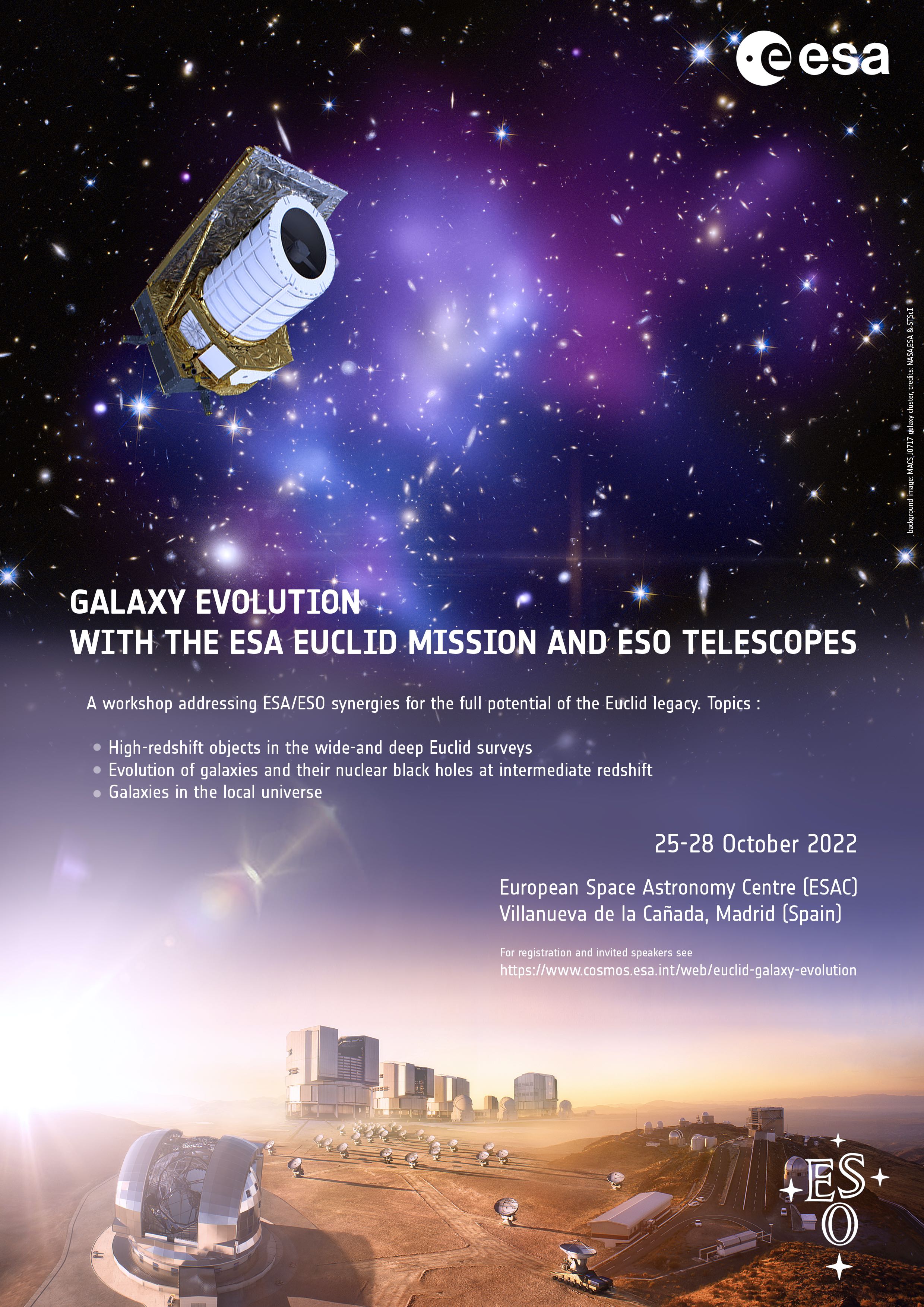Home - Euclid Galaxy Evolution
Galaxy evolution
with the ESA Euclid mission and ESO telescopes
25-28 OCTOber 2022
European Space Astronomy Centre (ESAC)
ESA, Villanueva de la Cañada, Madrid, Spain
Euclid is a high profile ESA mission with important participation from NASA and ground-based observatories around the world, to be launched in 2023. Euclid will provide near-IR imaging and slitless spectroscopy of a quality impossible to achieve from the ground (1). The mission aims at characterizing with unprecedented accuracy the properties of Dark Energy by mapping the evolution of the large-scale structures of the Universe over the past 10 billion years. In addition to the primary cosmology science case, Euclid will have a major impact on our understanding of galaxy formation, from cosmic dawn to the present time.
The workshop will address ESA/ESO synergies and beyond, for realizing the full potential of the Euclid legacy programmes. Sessions will cover three major areas of research:
- High-redshift objects in the wide-and deep Euclid surveys. The mission will generate the largest samples of high redshift objects ever assembled, with more than 100 z > 7 quasars brighter than JAB ~23 and thousands of z > 7 galaxies brighter than JAB ~26 from its deep survey covering 40 deg2. These samples will enable high impact studies of the history and topology of the epoch of reionization, of the growth of supermassive black holes and of the formation and evolution of the first galaxies.
Keynote speakers: R.Bouwens (U. of Leiden), P. Dayal (U. of Groningen), A.Cooray (UC, Irvine)
-
Evolution of galaxies and their nuclear black holes at intermediate redshifts. Euclid will be essential for tracing the stellar-mass build-up of galaxies in the first half of Universe’s history (z~1-7) with the largest statistics ever achieved, and relating it to their parent dark matter haloes with weak lensing and unprecedented galaxy clustering measurements. Euclid will provide the equivalent of SDSS-quality images of redshift 0.1 galaxies out to redshift 0.7, for detailed morphological studies. It will also generate of order of 100,000 strong gravitational lens systems, providing information on the mass distribution of galaxies as well as (sub-) structures of dark matter halos.
Keynote speakers: G.Rodighiero (U. of Padova), R.Maiolino (U. of Cambridge), S.Vegetti (MPA, Munich), T.Kodama (Tohoku U., TBC)
-
Galaxies in the local universe. The depth and resolution of the Euclid imaging data will enable resolved stellar population studies of the stellar streams and substructures and globular clusters in the Milky Way and the Local Group out to beyond M31.
Keynote speakers: Annette Ferguson (University of Edinburgh)
There will be reviews of the relevant observational capabilities intermixed in the programme: Euclid (F. Castander, IEEC-CSIC, Barcelona), the US perspective (J. Rhodes, JPL), UV-IR imaging, O-IR spectroscopy (Pascal Oesch, U. of Geneva), Radio (Nick Seymour, Curtin University), Sub-mm (Helmut Dannerbauer, IAC) and high-energy (Mara Salvato).
The intended outcome of this workshop is to position the Euclid community to profit optimally from the synergies of the ESA Euclid mission with the ESO facilities as well as other European, US and worldwide facilities. To this aim, a roadmap / white paper for the follow-up of Euclid sources will be published after the workshop.
The workshop is planned in hybrid format, in person attendance is encouraged but on-line participation is also possible.
There is no conference fees and lunches can be taken at the ESAC cafeteria.
(1) The Euclid Wide Survey will cover 15,000 deg2 of the high-latitude sky to AB magnitude depths of 26 in the visible (R+I+Z) for point-sourcess, and between 24 and 24.5 in the near-infrared Y, J and H filters, and an emission line sensitivity in slitless spectroscopy of 2 10-16 ergs.s-1.cm-2. The Euclid Deep Survey will reach 2-magnitude fainter sensitivities over 40 square degrees in three separate patches of the sky.

Special thanks to Ignacio de la Calle for the poster
- Removed a total of (6) style text-align:center;
- Removed a total of (1) style text-align:right;








































 Sign in
Sign in
 Science & Technology
Science & Technology